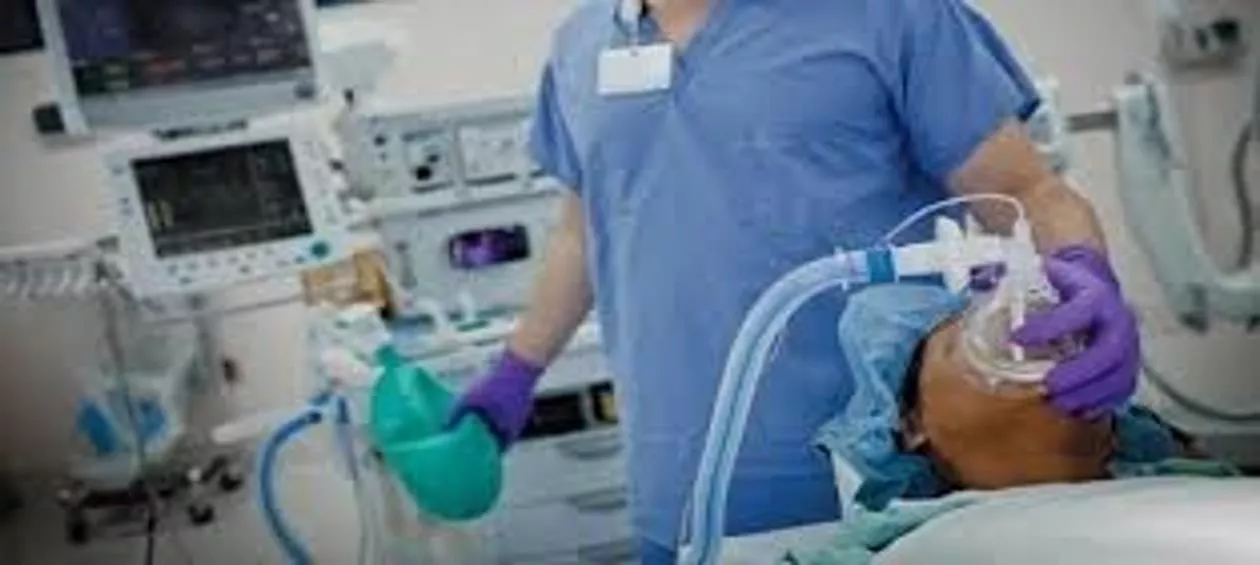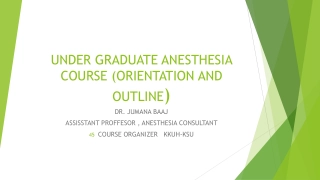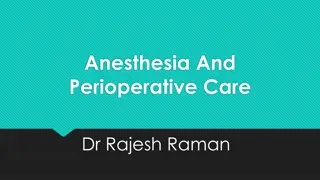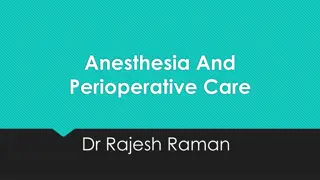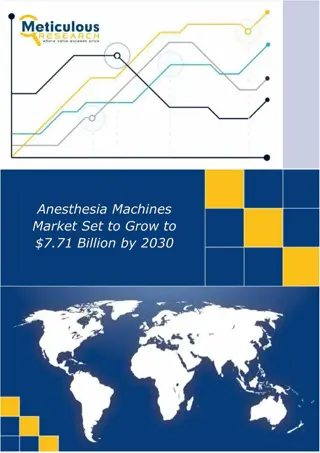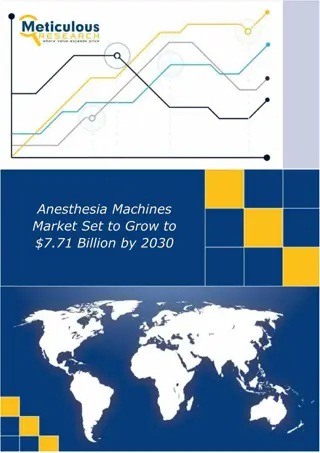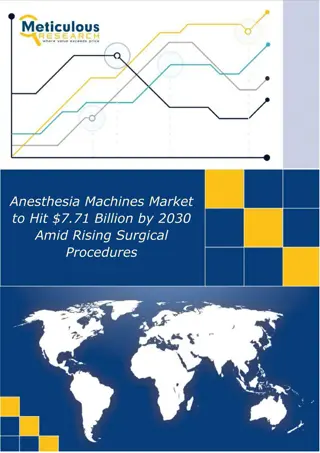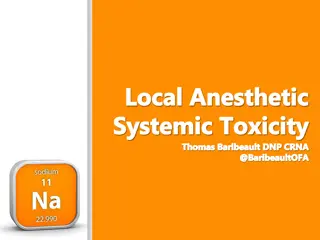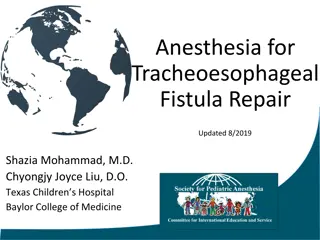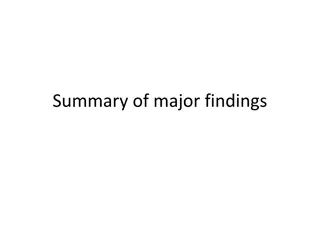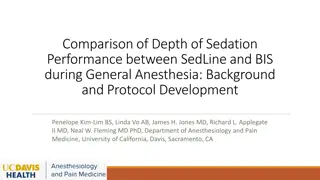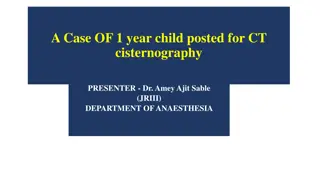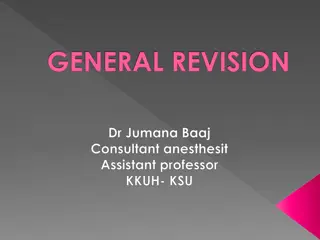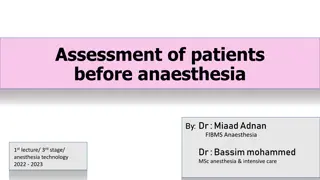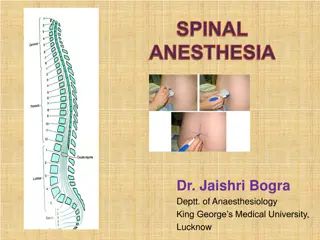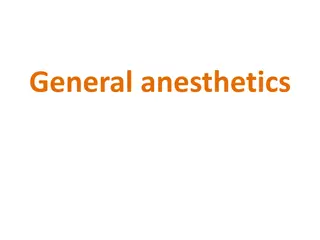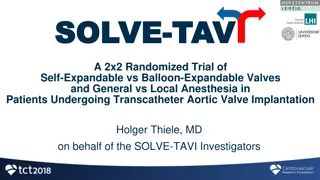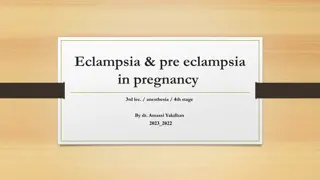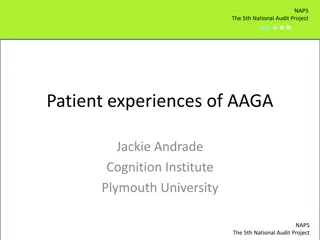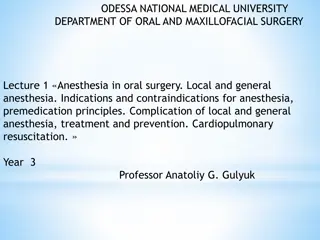Understanding Safety in Anesthesia Practice
Anesthesia carries inherent risks, making it a high-risk specialty in medicine. This presentation by Dr. Jumana Baaj delves into the complexities of anesthesia practice, highlighting the risks of complications, implementing safety measures in the operating room, and addressing common errors to enhance patient safety and outcomes.
Download Presentation

Please find below an Image/Link to download the presentation.
The content on the website is provided AS IS for your information and personal use only. It may not be sold, licensed, or shared on other websites without obtaining consent from the author. Download presentation by click this link. If you encounter any issues during the download, it is possible that the publisher has removed the file from their server.
E N D
Presentation Transcript
Safety in anesthesia Dr. Jumana Baaj Assist Professor , consultant anesthesia 19/03/2020
Anaesthesiology: A High risk Speciality bbp0 Anaesthesiology is a high-risk speciality as compared with other specialities in medicine
Objective Risk of anesthesia Complication of anesthesia How to implement anesthesia safety in OR Error related to complication factors threatening patient safety in the operation rooms General safety strategies Quality assurance Crucial errors to know and avoid Post operative pain Hypothermia sequences
Risk of anesthesia Anesthesia may contribute to death in about 1 per 10,000 to 1 per 200.000 anesthetics Many other patients suffer serious and costly nonfatal injuries such as permanent neurologic damage (paraplegia and vegetative state)
Complication of anesthesia Major Complications cardiac arrest Perioperative MI Aspiration Anaphylaxis Drug overdose Convulsion nerve pulses Organ injury Malignant hyperthermia Minor complications Airway obstruction Postop nausea, vomiting Sore throat Hemodynamic instability Pneumonia Delirium Shivering
10 common causes of cardiac arrest under anesthesia Drugs over dose & adverse events Arrhythmia Perioperative MI Airway obstruction High spinal Lack of vigilance Aspiration Bleeding Technical problem in anesthesia machine
Now we can see anesthesia event can cause severe results we should find out factors threatening patient safety in the operation room and search for strategies to deal with them
What makes anaesthesia safe ?
How to implement anesthesia safety in OR Standardization drug dosage , dosing units , concentration , drugs preparation methods workplace design Technology :drug identification and delivery system by utilization automated information system Pharmacy : dedicate pharmacy resource to the OR Culture: recognize and report the errors, learn from adverse events www.apsf.org
Error related to complication Technical accident Equipment failure Commincation error Limitation of therapeutic standard Limitation of available resources Limitation of supervision
factors threatening patient safety in the operation rooms Equipment Causes: Design flaw User error Malfunction Strategies: pre-use checkout
factors threatening patient safety in the operation rooms Equipment Causes: Design flaw User error Malfunction Strategies: pre-use checkout
Patient Causes Underlying diseases: hyperthyroidism-thyroid storm, diabetes-ketoacidosis , hyperosmolar coma Allergic reaction to some drug Strategies Preoperative evaluations
PRE ANESTHESIA CHECK check patient risk factor ASA 1,2,3,4,5, e in case of emergency Airway assessment Aspiration risk Allergies Abnormal investigation Comorbidity Medication Formulate anesthesia plan
Causes for Accidents There is a rarely a single cause for an accident
System error System failures are the main reason for accidents check anesthetic machine oxygen supply A backup O2 tank Never shut down audible alarms (very important) Emergency ventilation equipment
Human error Human error contribute to 70 80 % of anesthetic incidents Human error may involve : Misjudgments Failure to check equipment's Fault with technique Communication problem
Human error (anesthesia and surgeon) Anesthetist and Surgeon Human factors affecting performance such as : fatigue, noise, boredom, long hours, hunger, tension Human error is a strong contributor Deviations from accepted anesthesia practices. A lapse in vigilance and no attention to details Vigilance lets anesthetists find abnormal signs as early as possible Vigilance allows the anesthetist to remain aware of surrounding events and signals while performing other tasks Vigilance lets anesthetist find abnormal sign as early as possible Vigilance allows the anesthesit to remain
General safety strategies A. Prepare a peri-operative plan Preoperative visit to the patient to let us know the patient s condition in detail Make an anesthesia plan to let us know clearly how to perform the anesthesia and how to deal with possible crisis B. Develop situational awareness Use a systematic approach to scanning the machine, monitors, patient, surgical field, and surroundings If one vital sign is anomalous, quickly assess the others while repeating the measurement and observing what is happening on the surgical field. C. Verify observations, Cross-check observations, Assess co varying variables Review it with a second person
General safety strategies D. Implement compensatory responses If something wrong happens urgently, first implementing time-buying measures. e.g., increase the fraction of inspired oxygen when oxygen saturation falls; administer intravenous fluids or vasopressors when hypotension occurs). Then search out any correctable primary cause and treat it appropriately E. Prepare for crisis If there is any critical events happened (cardiac arrest, malignant hyperthermia or difficult intubation), call for help early (WHY), then use accepted protocols for emergencies and resuscitation (e.g., advanced cardiac life support, malignant hyperthermia protocols).
General safety strategies F. Enhance teamwork; enhance teamwork communication, address surgeons and nurses early in the case by names. Make requests and delegate tasks clearly and specifically by name (e.g., Jack, do task X and tell me when task X is completed. ). G. Compensate for stressors (Anesthetist is a stressful job). If you feel very tired, ask for a relief. Reduce various stressors: noise, fatigue, interpersonal tension, etc. optimize the work environment Learn from close calls Every mistake is an opportunity to learn and improve. Analysis and feedback of adverse events to identify and assess system problems I.
Quality assurance The aim is improving the quality of care and minimizing the risk of injury from anesthesia. A. Documentation Any adverse events should be reported truthfully, discussed, analyzed to identify causes and assess system problems. So we can learn from them and develop patterns to prevent recurrence. Standards and guidelines :Anesthesists should be aware of their institution's safety policies and procedures. These should include those for monitoring, response to an adverse event, handoff checklist, resuscitation protocols, perioperative testing, and any special procedures or practices for the use of drugs, equipment, and supplies. C. Safety training Anesthesia providers should obtain training in safety to learn and maintain basic skills. Simulation based training techniques B.
Crucial errors to know and avoid A. Airway errors , patients receiving general anesthesia have no spontaneous respiration due to use of muscular relaxants, their respiration is controlled by machine via endo-tracheal tube. So we must ensure oxygen supply and avoid accidental extubation during surgeries (prone surgery) and transport. Once it happens, It can cause severe hypoxia and directly threaten the patient life.
How to avoid Check the system and guarantee it to function well Verify the position of end tracheal tube by auscultation for breath sounds bilaterally and detecting ETCO2 with proper fixation Closely observe the vital signs Be care when position the patient in prone position
B. Medication errors Administration of undiluted potassium by rapid intravenous infusion can cause ventricular fibrillation and cardiac arrest. Neostigmine given without an antimuscarinic drug can cause asystole, severe bradycardia and atrioventricular block and can be fatal. Succinylcholine can cause severe hyperkalemia and dysrhythmias, may trigger malignant hyperthermia. Medications to which a patient is allergic can cause anaphylaxis. Administering the wrong blood can cause an incompatibility reaction that can be fatal.
How to avoid Be Familiar with the medication you use know clearly its indications and contraindications. Administrate the medication strictly according to instructions. Know the patient s history of allergy ,Cross-check blood type.
Medication Human error: most common All drugs should be clearly labelled; cross check before administering
Basic medication safety Label all syringes Eliminate look like ampoules Read label before administration Distinctive drug labels Color coding Barcoding
Procedure errors Inadvertent intravascular injection of local anesthetics during a nerve block can cause neurologic and cardiac toxicity, Avoid epidural hematoma (Hx of coagulopathy) Air embolism : with insertion or removal of central line
How to avoid Adequate preoperative evaluation Follow standards giudelines Vigilance
V. Standards and protocols Standards for basic anesthetic monitoring Qualified anesthesia personnel shall be present in the room throughout the course of all general anesthetics, regional anesthetics, and monitored anesthesia care Continually evaluate the patient's respiration ,circulation and temperature 1.
Guidelines for action after an adverse anesthesia event The anesthesiologist involved in an adverse event should do the following: Provide for continuing care of the patient. Notify the anesthesia operating room administrator as soon as possible. If a resident or certified registered nurse anesthetist was involved in the event, (s)he should notify the attending staff. dont discard supplies or tamper with equipment. Document events in the patient record (including the serial number of the anesthesia machine). Stay involved with the follow-up care. Contact consultants Submit a follow-up report to the department quality assurance committee. Document continuing care in the patient's record 1. 2. 3. 4. 5. 6. 7. 8.
PPoostst CriCrissiiss Avoid blame culture Develop Help Culture
Post operative pain Multimodal analgesia Preemptive preventive analgesia Greater use of regional anesthesia technique Regular analgesia technique not PRN Identify problematic patient and formulate management plan
Why opioid free analgesia Because opioids lead to: PONV delay of start feeding Bladder bowel function Sedation delay mobilization , patient discharge , Pulmonary complication immuno-suppressive effects infection cancer recurrent /mets Inadequate analgesia persistence post-op pain into chronic pain
Hypothermia:peri-operative morbidity/mortality Consequences of hypothermia Shivering/oxygen requirement increased: myocardial oxygen supply / demand Infection: Directly depress immune function, Vasoconstriction- reduced tissue oxygen- predispose to infection Delay would healing Bleeding / transfusion: Depressed platelet and coagulation Depressed Cardiac function and risk for arrhythmias Delay recovery from anesthesia
Postoperative infection-Anesthetic role ole Antibiotic prophylaxis Hand hyogein Aseptic precausion for invasive procedures Fluid balance , blood transfusion Oxygen avoiding hypoxia/hyperoxia
Recommendations for Airway Management in a Patient with Suspected Coronavirus (2019-nCoV) Infection
Patients with confirmed or suspected 2019-nCoV infected cases: o Should NOT be brought to holding or PACU areas o Should be managed in a designated OR, with signs posted on the doors to minimize staff exposure. o Should be recovered in the OR or transferred to ICU into a negative pressure room. Ensure a high quality HMEF (Heat and Moisture Exchanging Filter) rated to remove at least 99.97% of airborne particles 0.3 microns or greater is placed between the ETT and reservoir bag during transfers to avoid contaminating the atmosphere.
Plan ahead: For time to allow all staff to apply PPE and barrier precautions Consider intubation early to avoid the risk of a crash intubation when PPE cannot be applied safely.
During Airway Manipulation Apply: Disposable mask, goggles, footwear, gown and gloves. Consider adopting the double glove technique. Standard ASA monitoring should be applied before induction of anesthesia. N95 mask at a minimum should be utilized. PAPR devices may offer superior protection when manipulating an airway of an infected patient. Assign Designate the most experienced anesthesia professionals available to perform intubation, if possible. Avoid trainee intubation for sick patients.
Avoid: Awake fiberoptic intubation, unless specifically indicated. Atomized local anesthetic can aerosolize the virus. Prepare to: Preoxygenate for 5 minutes with 100% FiO2 o Perform a rapid sequence induction (RSI) to avoid manual ventilation of patient's lungs and potential aerosolization of virus from airways. Consider using a video-laryngoscope. Use: Ensure there is a high quality HMEF (Heat and Moisture Exchanging Filter) rated to remove at least 99.97% of airborne particles 0.3 microns or greater placed in between the facemask and breathing circuit or between facemask and reservoir bag.
Dispose: Re-sheath the laryngoscope immediately post intubation (double glove technique) Seal all used airway equipment in a double zip-locked plastic bag. It must then be removed for decontamination and disinfection. Remember: After removing protective equipment, avoid touching your hair or face before washing hands.
The goal is to provide highest standard of care and safety in any sitting International Task Force on Anaesthesia Safety Approved by: World Federation of Societies of Anaesthesiologists (WFSA)
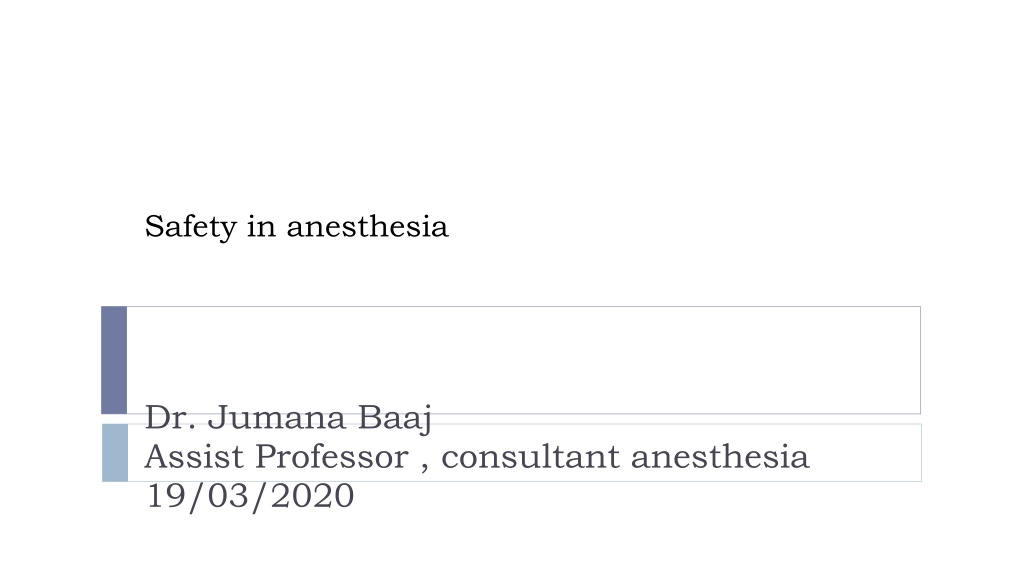
 undefined
undefined



 undefined
undefined


